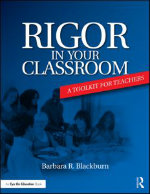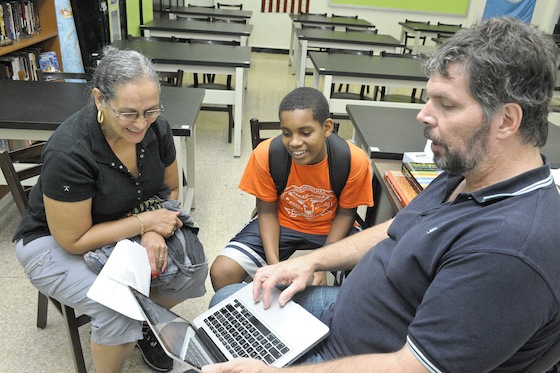PAIRing with Parents to Improve Student Learning
 By Barbara Blackburn
By Barbara Blackburn
Would you like to improve your relationship with parents and families? Teachers benefit when learning is reinforced and supported from home. Let’s discuss how to PAIR with parents to improve student learning. (I’ll be using the word parents, but consider it all inclusive with families.)
|
PAIR with Parents Partnerships are a Two-Way Street Accentuate the Positive Inform and Transform Relationships are Shared |
Partnerships are a Two-Way Street
A true partnership is more than communication from school to home. Although it’s our responsibility to take the initiative to form partnerships where everyone has a role. I’ve found that most parents are willing to help, but they need specific ways to help.
Kendra Alston, a former middle school teacher in North Carolina’s Charlotte-Mecklenburg Schools, sent home an interactive newsletter every two weeks. Besides the information, she included a question for parents to answer and send back. She had a high return rate because students received points for returning the newsletter. She also used interactive homework. Kendra said:
For example, I’ll take a picture of something my students did in school. Then, I write ‘ask me what I learned today’ at the top of the page. The parents are asked to write what their son or daughter said. This lets me know if the students even remember what happened. I’m also always about getting feedback on my own performance and when the parent writes a reflection on what their child is learning, it gives you insight on how well you taught.”
Accentuate the Positive
I called every parent during the first month of school to introduce myself and tell them something positive about their son or daughter. I thought of parent relationships like a bank; I needed to make a deposit before I made a withdrawal. I didn’t want my first phone call to be the one about a poor grade or a discipline problem.
One time it took 17 calls to reach a parent before I was finally successful. It took about five minutes to convince her I wasn’t calling because Marcus was in trouble. She finally said she had never received a call from a teacher telling her something positive about her son. She thanked me and immediately offered her help anytime I needed it.
Five weeks later when Marcus was having (and making) trouble in class, she supported me 100%. Focusing on the positive and making an extra effort has benefits for you, your students, and their parents.

For example, on Pinterest, don’t name your boards with your location or your full name. Also, there are private blogs that require invitations or membership, so you can control who sees the information if you so choose.
|
Social Media Tools for Sharing Positive News • Pinterest to share samples of student work (code or remove names for privacy; do not post grades). • Blog to share descriptions of the positive things going on in your classroom. • Tumblr to share videos of class activities and presentations (remember to get permission for recording). |
Inform and Transform
When I talk to parents, many of them feel as though there is a hidden code in schools – a code they don’t understand. Margo and her son moved to a new area when Jared started middle school. She missed the first parent-teacher meeting because she was working. She called the school and left several messages asking to meet with his teachers but didn’t receive a return call.
Margo was frustrated when she told me her story. Another teacher at the school was in one of my college classes, so I talked with her. I discovered that the school had a policy that all appointments with teachers were scheduled with the attendance secretary, so the entire teaching team could meet with parents without scheduling conflicts. My graduate student said the principal always explained the policy at the first meeting.
Of course, Margo didn’t know because she wasn’t at the meeting, and she thought the teachers were just ignoring her. One phone call later, she connected with the teachers, and she and Jared finished the year successfully.
Building partnerships with parents is founded on informing parents about what is going on in your classrooms, which transforms the relationship. You want parents to feel that they are truly a part of your classroom. And that can’t happen if they don’t know or understand what you are doing.
Kendra believes that communication is an important part of her job. During the first two weeks of school, she guided her students as they created a brochure for parents about their classroom.
“The students do all preliminaries, I just put it together. I tell them my philosophy, then each block gets together and comes up with a quote that describes their class. It also includes a poem I write to parents every year that finishes by asking for support from them. I always finish with the message that I can’t do anything without you.”
Relationships are Shared

There is no way you can truly help your students be successful without the support of their parents. And it’s up to you to take the first step. Suzanne Okey, a former teacher of students with special needs, points out that sometimes PTA meetings and phone calls are not enough.
In terms of families, I’m big on home visits. I feel like it’s always fair to get off your turf and go into the environment where they are most comfortable. It says this is a two way street; I’m not expecting you to make all the accommodations; I’ll meet you where you are.
If teachers truly want to form partnerships, they cannot expect it all to be “come to me”; you have to be willing to go to them. Sometimes I sent a letter. It is important to give them options, such as meeting them in neutral places (the public library or McDonald’s) in order to preserve their privacy and dignity. Not everyone has transportation or telephones, and they don’t want to advertise that to world.
It’s our job to connect and engage
It’s our responsibility to connect with parents and families – to really engage with them. The benefits outweigh any costs in terms of time. Involve your students, and be creative as you look to build a partnership, rather than a one-way street, with parents and families.
Adapted from: Rigor in Your Classroom: A Toolkit for Teachers.




































